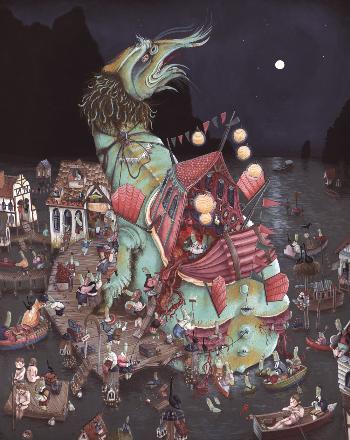Whitehot Magazine
April 2024
"The Best Art In The World"
"The Best Art In The World"
April 2024
October 2008, Allison Sommers

An ingeniously complex group of whimsical creatures recently made their home at a hip Los Angeles art gallery called Thinkspace. The brainchildren of Virginia-based visual artist Allison Sommers, these creatures and their intricate worlds materialize in “Waterways”, which recently exhibited from August 8 through September 5.
Collectively describing Sommers’ recent exhibition provides somewhat of a challenge. Ostensibly, Sommers’ recent work could fall under the category of fantastic art, such that it conveys dream-like, uncanny, and often grotesque depictions. Fantastic art borrows momentum from Mannerism, an older art genre characterized by spatial incongruity, exaggerated and elongated subjects, and an often disturbing lack of any clear perspective (think of European art at the height of the Renaissance). Indeed, Sommers admits that the “exaggerated pathos” in Mannerism is the primary inspiration behind her current work; in a larger sense, Sommers’ artwork seeks to culminate at the point where seriousness gives way to ambiguity. Her artwork is fascinating, enigmatic, and visually befuddling, illustrating a vivid binary of gravity and frivolity.
Themes of morbidity run rampant throughout this exhibition despite colourful and almost comical exteriors. The oxymoronic expression “playfully morbid” comes to mind. Sommers often undergoes the painstaking diligence of developing her characters, only to carelessly thrust them into grisly predicaments. Horrific situations that involve slow, destructive processes (such as creatures eating each other alive) both fascinate and disturb Sommers; to rectify this, she creates ways to ‘make fun’ of such scenarios. Sex and eating are two major themes of her artwork, the latter of which she describes as often being “unsettling and creepy”. Regardless of some thematic imagery, however, Sommers’ artwork is notably complicated, and virtually impossible to definitively ‘unpack’. Sommers admittedly does little to guide her viewers toward meaning within her work.
“The Concubine’s Attic” captures a nude woman just moments before her suicidal death. According to Sommers’ initial intentions, the woman is a lonely concubine in a man’s attic, completely neglected except when being ‘used’ by her captor. Abandoned in this cramped attic following a devastating flood (which likely leaves most everyone else dead), the woman decides to commit suicide via drowning. This scene lends itself to another example of Sommers’ repetitive imagery: rooms. Sommers consistently returns to the concept of rooms, or tiny houses, in her artwork. These microcosmic spaces that theoretically contain everything one needs (but are nonetheless lacking) are the “coziest and loneliest” of concepts to Sommers.
The slightly more light-hearted “Got Me One” is described by Sommers as a “quick visual joke,” wherein a sailor on the stormy seas believes that he is harpooning a busty mermaid; in reality, he’s in store for a much less fortunate fate…
Over a dozen other paintings in gouache tell their own unique stories. Allison Sommers is currently brainstorming for a solo exhibition to be featured at Thinkspace in May of 2009.

Rachel Bateman
Rachel Bateman is a writer in LA.
rachelj82@gmail.com












